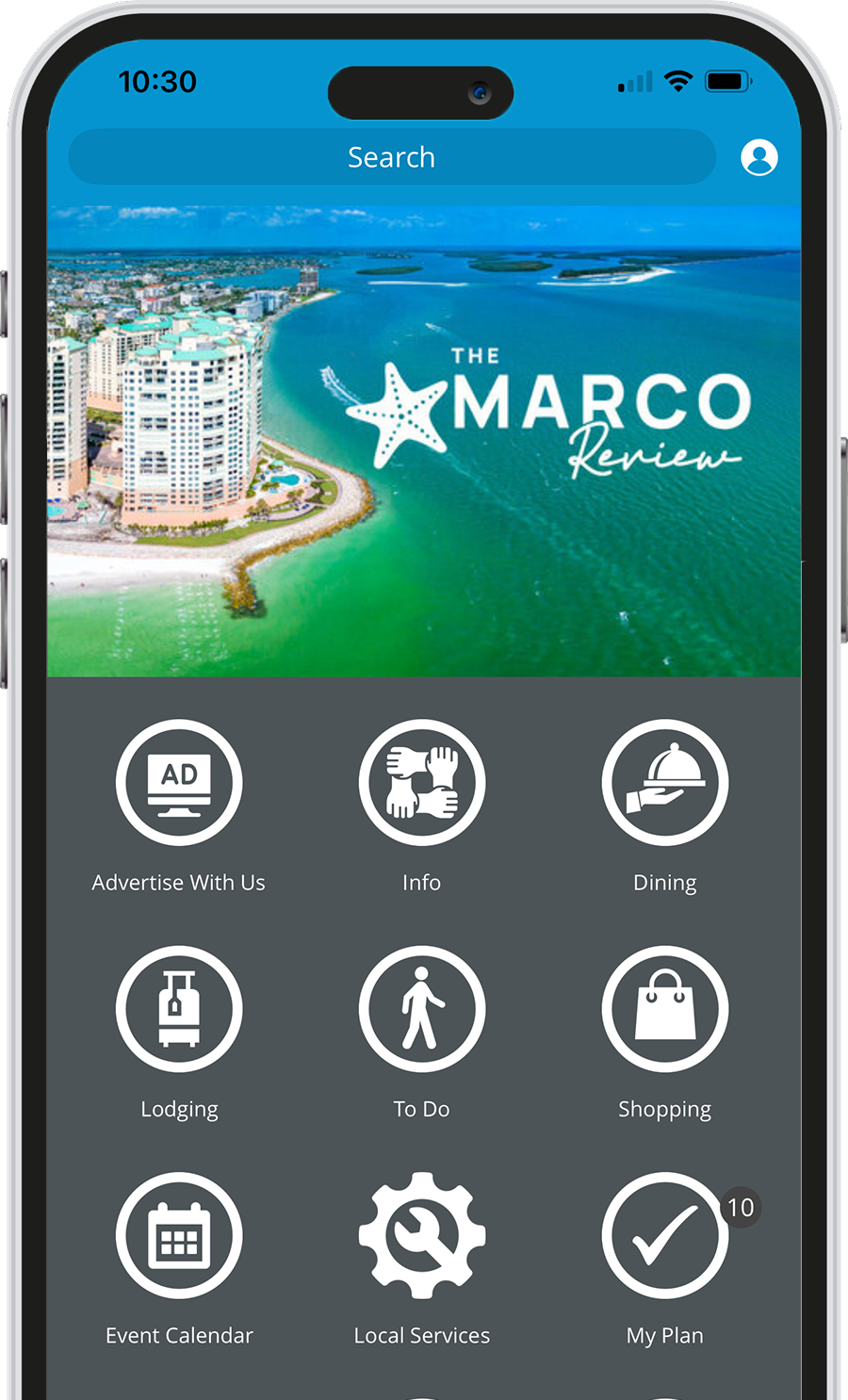Marco Island Wildlife: Top 5 Wild Animals You Can See in Paradise
Marco Island, the largest of Florida’s Ten Thousand Islands, is not only famed for its white-sand beaches but also for its thriving wildlife. This tropical paradise has about 16,000 year-round residents, swelling to around 40,000 in winter with seasonal visitors and snowbirds drawn by the warm climate and natural beauty. Many of those visitors are nature enthusiasts eager to encounter Marco Island’s wildlife up close. In this travel-guide overview, we’ll introduce Marco Island’s 5 most famous and loved wild animals, along with tips on where and when you might spot them in their natural habitats.
1. Bottlenose Dolphins
Bottlenose dolphins are arguably the superstars of Marco Island’s wildlife scene. These intelligent and sociable marine mammals are often seen swimming just offshore or riding the wake of boats. They can reach 10–14 feet in length and about 1,100 pounds as adults, yet they display remarkable agility – frequently breaching the water’s surface to the delight of onlookers. Dolphins live in close-knit pods and are curious creatures; it’s not uncommon for them to approach humans or boats in a friendly manner. In fact, local tour operators are so confident in the abundance of dolphins around Marco Island that many “guarantee dolphin sightings” on their excursions.
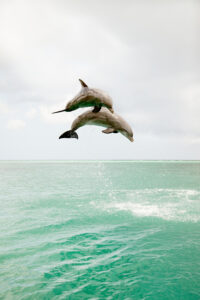
Where to see them: The waters around Marco Island (especially in the Ten Thousand Islands mangrove area) are prime dolphin territory. Consider joining a guided eco-tour by boat or jet ski, which greatly increases your chances of meeting these cheerful marine mammals – guides know the pods’ favorite hangouts and often find dolphins within minutes. Early morning and late afternoon are excellent times to spot dolphins when the Gulf is usually calmer. Occasionally, you might even see dolphins from shore at places like Tigertail Beach or Caxambas Pass, playing in the surf.
2. West Indian Manatees (Florida Manatees)
The Florida manatee – a subspecies of the West Indian manatee – is often called a “sea cow” for its slow, grazing habits and rotund shape. These gentle giants are an iconic Florida species and a favorite among wildlife lovers. Florida is the only place in the United States with a wild population of manatees, and the estuaries and coastal bays near Marco Island are part of their home range. Manatees are huge (adults can weigh 1,000 pounds or more), yet they have endearingly peaceful dispositions, spending up to 8 hours a day munching on seagrass and other aquatic plants. Seeing a manatee up close – with its whiskered snout poking above water as it comes up for air – is a truly heartwarming experience for many visitors.
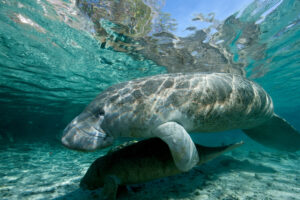
Where and when to see them: Manatees can be trickier to spot than dolphins, as these slow-moving mammals often blend into murky channels or lagoons. Your best bet is to visit during the cooler months from late November through spring, when manatees gather in warmer waters and are more active in the daytime. In winter, manatees often seek refuge in the warmer intracoastal waters, canals, and sheltered bays around Marco Island (especially on chilly days when the Gulf temperature drops). One popular way to encounter them is by kayaking or paddleboarding through mangrove tunnels and estuaries – keep your eyes peeled for a large gray shadow in the water or a snout breaking the surface. Guided manatee eco-tours are available as well, with operators who know the spots where manatees like to congregate.
3. Loggerhead Sea Turtles
Sea turtles are a cornerstone of Marco Island’s natural heritage. Five species of sea turtles live in South Florida (including green, leatherback, Kemp’s ridley, and hawksbill), but the loggerhead sea turtle is by far the most common around Marco Island. In fact, Marco’s sandy beaches provide crucial nesting grounds for loggerheads. On average about 80 loggerhead nests are laid each year across the island’s 4-mile stretch of beach. Each May through early August, adult female loggerheads crawl ashore at night to dig nests and lay eggs in the sand. Roughly 60 days later (from early July through October), the tiny hatchlings emerge and make their perilous dash to the sea under cover of darkness. If you visit in summer, you’ll notice sections of beach marked off with stakes and tape – these indicate turtle nests being monitored by wildlife officials.
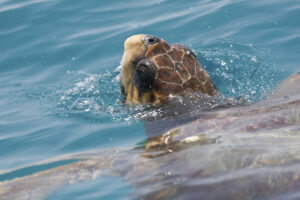
Where and when to see them: The sea turtle nesting season runs from May 1 to October 31 on Marco Island’s beaches. If you’re visiting in summer, you have a chance (with luck and proper timing) to witness a nesting mother or hatchlings, but it requires caution and often a nighttime outing. If you’re on the beach at night, follow all local guidelines: no white lights or flash photography (use red filters on any lights), keep your distance if a turtle comes ashore, and never disturb a nesting turtle or hatchlings. Early morning beachgoers can often spot turtle tracks in the sand at dawn, which look like tractor tire marks coming from the water – evidence that a turtle nested the night before.
4. Burrowing Owls
Surprise – one of Marco Island’s most adored wild animals is actually a tiny owl that lives underground! The Florida burrowing owl is a small, long-legged owl (about 9 inches tall when standing) that digs burrows instead of nesting in trees. Marco Island is famous for its thriving community of burrowing owls, which have adapted remarkably well to suburban life. In fact, hundreds of owl pairs live on the island, often burrowing in open empty lots, gardens, and even along roadsides in this residential community. They have become a cherished part of the local environment. Thanks to conservation efforts, the island’s burrowing owl population has grown to over 400 individuals today, making Marco one of the densest owl populations in Florida.
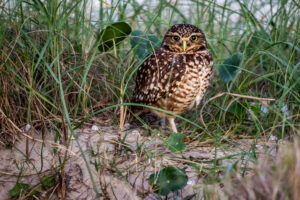
Where and when to see them: Burrowing owls live year-round on Marco Island, so you can look for them in any season. They tend to be easiest to spot in the morning and late afternoon when they are often outside the burrow either feeding or scanning for predators. A good strategy is to explore the quieter residential areas and undeveloped lots – especially those that have been left grassy – around the island.
5. Bald Eagles
Marco Island’s skies are graced by one of America’s most iconic birds: the American bald eagle. In fact, the bald eagle holds special significance here – the city’s official seal and logo feature an eagle, and there’s an active eagle nest that the community has rallied to protect. Bald eagles typically nest in tall trees, and on Marco Island they have favored some of the remnant stands of Australian pine and other tall trees near the shore.
Tigertail Beach, a beautiful nature-rich beach on the north end of the island, is the hotspot for bird enthusiasts hoping to see eagles. The area around Tigertail is recognized as one of the best birding sites in Southwest Florida, with sightings of everything from bald eagles to osprey, herons, egrets, and pelicans reported regularly. A mated pair of bald eagles has a well-known nest at the Marco Island Nature Preserve and Bird Sanctuary (near Tigertail), which even features a live webcam for remote viewing. This means that the chances of seeing an eagle on Marco are quite good if you know where to look and when.
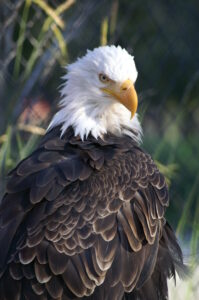
Where and when to see them: The prime time for eagle activity on Marco Island is during the dry-season months of October through May, which coincides with their nesting season. If you visit in winter, you might catch the resident eagle pair refurbishing their nest, incubating eggs (usually laid in late fall or early winter), or feeding their young. A great strategy is to head to Tigertail Beach or the nearby Nature Preserve in the early morning or around sunset – eagles are often seen hunting for fish over the lagoons or perched on high branches at those times. Bring binoculars for a closer look at tree tops; you may spot the white head of an adult eagle standing out against the greenery.
Tips for Wildlife Watching on Marco Island
To make the most of your wildlife adventures on Marco Island, keep these travel tips in mind:
-
Plan for the Season: The dry winter season (November–April) is generally the best time for wildlife spotting. Cooler, dry weather means animals like birds and alligators (in nearby Everglades) are more active and easier to find, and you’ll avoid the summer nesting restrictions and thunderstorms. That said, summer offers unique experiences like sea turtle nesting – just be prepared for heat, humidity, and bugs if you visit then.
-
Go Early or Late in the Day: Many animals are most active at dawn and dusk. Try a sunrise beach walk to see turtle tracks or dolphins, or an early evening stroll near wetlands to catch birds and owls at feeding time. Midday heat can make wildlife hide in the shade. Plus, the softer morning and late afternoon light is ideal for photography.
- Visit the Right Spots: Marco Island has several great wildlife-viewing locations. Tigertail Beach is excellent for bird watching (as noted, eagles, osprey, and wading birds frequent the area). The Everglades National Park and Big Cypress Preserve are a short drive away for those eager to see alligators, wading birds, or even a Florida panther in the wild.
-
Respect the Wildlife: This is the golden rule – both for your safety and the animals’. Observe from a safe distance and use binoculars or zoom lenses for a closer look, rather than getting too close. Harassing or feeding wild animals is not only harmful to them but also often illegal (feeding dolphins, pelicans, alligators, sea turtles, etc. is against the law). If an animal changes its behavior because of your presence (e.g., an owl flushes from its perch or a dolphin moves away), you’re too close.
-
Take a Guided Tour: If you’re new to wildlife watching or short on time, consider joining one of Marco Island’s many wildlife tours. Knowledgeable guides can greatly enhance your experience – they know exactly where to find manatees on a cool morning, which mangrove tunnel often hides an owl, or how to spot that camouflaged sea turtle in the water. Popular options include dolphin-spotting boat tours, kayak excursions through Rookery Bay, and sunset cruises that combine sightseeing with nature commentary.



